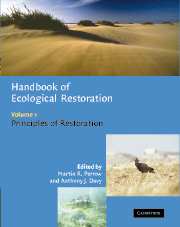Book contents
- Frontmatter
- Contents
- List of contributors
- Foreword
- Preface
- Part 1 The background
- Part 2 Manipulation of the physical environment
- 6 Terrestrial systems
- 7 Wetlands and still waters
- 8 Running water: fluvial geomorphology and river restoration
- Part 3 Manipulation of the chemical environment
- Part 4 Manipulation of the biota
- Part 5 Monitoring and appraisal
- Index
- References
6 - Terrestrial systems
Published online by Cambridge University Press: 29 December 2009
- Frontmatter
- Contents
- List of contributors
- Foreword
- Preface
- Part 1 The background
- Part 2 Manipulation of the physical environment
- 6 Terrestrial systems
- 7 Wetlands and still waters
- 8 Running water: fluvial geomorphology and river restoration
- Part 3 Manipulation of the chemical environment
- Part 4 Manipulation of the biota
- Part 5 Monitoring and appraisal
- Index
- References
Summary
INTRODUCTION
Mining, overgrazing, deforestation, cultivation and soil compaction dramatically alter the physical environment of terrestrial ecosystems. Among the more serious changes are damaged hydrologic processes (infiltration and runoff), accelerated erosion (fluvial and aeolian) and unfavourable micro-environmental conditions (wind, temperature and relative humidity). These changes inhibit both natural recovery processes and our ability to direct successional development with ecological restoration.
Properly functioning ecosystems have natural recovery processes that maintain sustainable flows of soil, nutrients, water and organic materials. During degradation, positive feedback mechanisms reinforce and accelerate damaging processes (Fig. 6.1), leading to irreversible vegetation change once a site's capacity for self-repair has been exceeded (Rietkerk & van de Koppel, 1997). Contemporary succession theory describes this catastrophic change as having crossed a transition threshold that inhibits natural recovery (Friedel, 1991; Laycock, 1991; Walker, 1993; Rietkerk & van de Koppel, 1997). Designing restoration strategies that overcome threshold barriers to natural recovery processes is one of the more important challenges for ecological restoration. That requires an understanding of treatment strategies that reduce threshold barrier effects.
Two types of threshold barriers limit the natural recovery of damaged ecosystems (Whisenant, 1999). It is important to distinguish between the two, because they require different restoration approaches. The first is controlled by interference from other organisms (biotic interactions), usually invasive weeds or other plants that prevent natural recovery (Fig. 6.2). Reducing problematic species (e.g. selective plant removal with herbicides, fire, mechanical, or hand treatments) and/or adding appropriate species are the most effective strategies for these circumstances.
- Type
- Chapter
- Information
- Handbook of Ecological Restoration , pp. 83 - 105Publisher: Cambridge University PressPrint publication year: 2002
References
- 24
- Cited by



